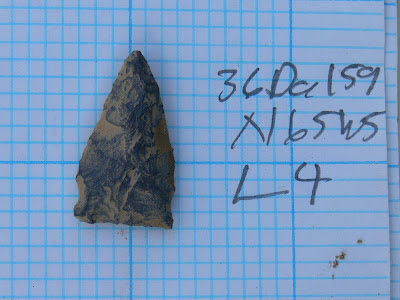 |
| Early Morning view of the Gardens at Fort Hunter Mansion and Park |
Archaeologist are generally outdoor lovers and can take most any weather in stride-rain, heat, snow- we pretty much persevere and keep on digging. The weather this week was stellar and the gardens surrounding our units at Fort Hunter provided a picturesque venue for excavations- pretty darn close to ideal conditions. The focus this week has been cleaning the floors and walls and digging the units around the well so that it can be safely excavated. We are hoping to have someone excavating in the well during Fort Hunter Day on Sunday, September 16th.
 |
| Visitors at Fort Hunter Day 2011 viewing excavation block |
Excavating in the units along the south wall of our large excavation block yielded small flakes in a variety of materials including black chert, green chert, quartz, quartzite, and metarhyolite. A diabase biface and a chert Brewerton Eared-notched projectile point were also recovered. The projectile point dates to the Late Archaic period or about 4,000 to 5,000 years ago. Stratigraphically, this coorelates well with the levels above which dated to the Transitional period. The size and the shape of the flakes indicate that they were the result of the re-sharpening of tools. Although, re-sharpening and general tool maintenance were common activities, two chert pebble cores were also recovered from the Late Archaic occupation indicating that initial tool production was also taking place. It is easy to imagine native peoples traveling along the Susquehanna River Valley and stopping on this high bluff overlooking the river to camp for a few days to hunt or fish.
 |
| Brewerton eared-notched projectile point |
Excavations on the north end of the block resumed with removal of the remaining A horizon soil in a single excavation unit. This unit contained a fire-cracked rock (FCR) hearth feature which was partially excavated in adjacent units last year. An additional twenty-five pieces of FCR were recovered along with lithic flakes produced from retouching/re-sharpening stone tools.
 |
| Fire-cracked rock feature before removal of artifacts |
 |
| Excavation block after removal of artifacts |
This area of the excavation block has produced a very early form of prehistoric pottery in the Susquehanna Valley identified as Vinette I. None of the recovered sherds are very large, but their distinct interior and exterior cord impressed markings, quartz temper, along with a rather thick, crumbly body are readily identified. The recovery of broadspears and narrow stemmed points, and this early pottery indicate a Transitional & Early Woodland floor which dates to approximately 3000-2000 years ago.
We scraped and cleaned the walls surrounding the well feature, but have not proceeded with any further excavations. We hope to start removing some of the fill from the shaft that washed in over the winter late this week or early next week. Removing the well will require stepping back into the surrounding units and those soils must first be removed in order to insure a safe excavation.
 |
| The "Grand" staircase into our excavation block. |
The depth of our excavation block has presented challenges for carrying equipment and buckets in and out of our units. To the rescue was our own handyman Jim Herbstritt, who created a deck and stairs from wooden pallets. A fine display of low budget craftsmanship, but this moveable staircase has been a welcomed addition for navigating the excavation block.
 |
| Archaeological Conservancy tour group |
Our visitors to the site have included children and adults, this week we were honored to be a featured stop on the French & Indian War tour sponsored by the Archaeological Conservancy which was followed by a visit to The State Museum to view our gallery and collection on exhibit from the excavations at Fort Hunter.
 |
| Boys from youth camp learning about Fort Hunter from Elizabeth Johnson, Jim Herbstritt and Kurt Carr |
Several school groups have visited the site along with random visitors just stopping in to see what we are doing and watch over the excavations. Our faithful volunteers have been helping once again, and a few new folks have joined in our excavation.
If you are interested in seeing the excavations, we will be at Fort Hunter from 10:00 a.m. to 5:00 p.m. this Sunday. We are also on site all next week from 9:00 a.m. to 4:30 p.m.- hope to see you soon!
For more information, visit PAarchaeology.state.pa.us or the Hall of Anthropology and Archaeology at The State Museum of Pennsylvania .
No comments:
Post a Comment